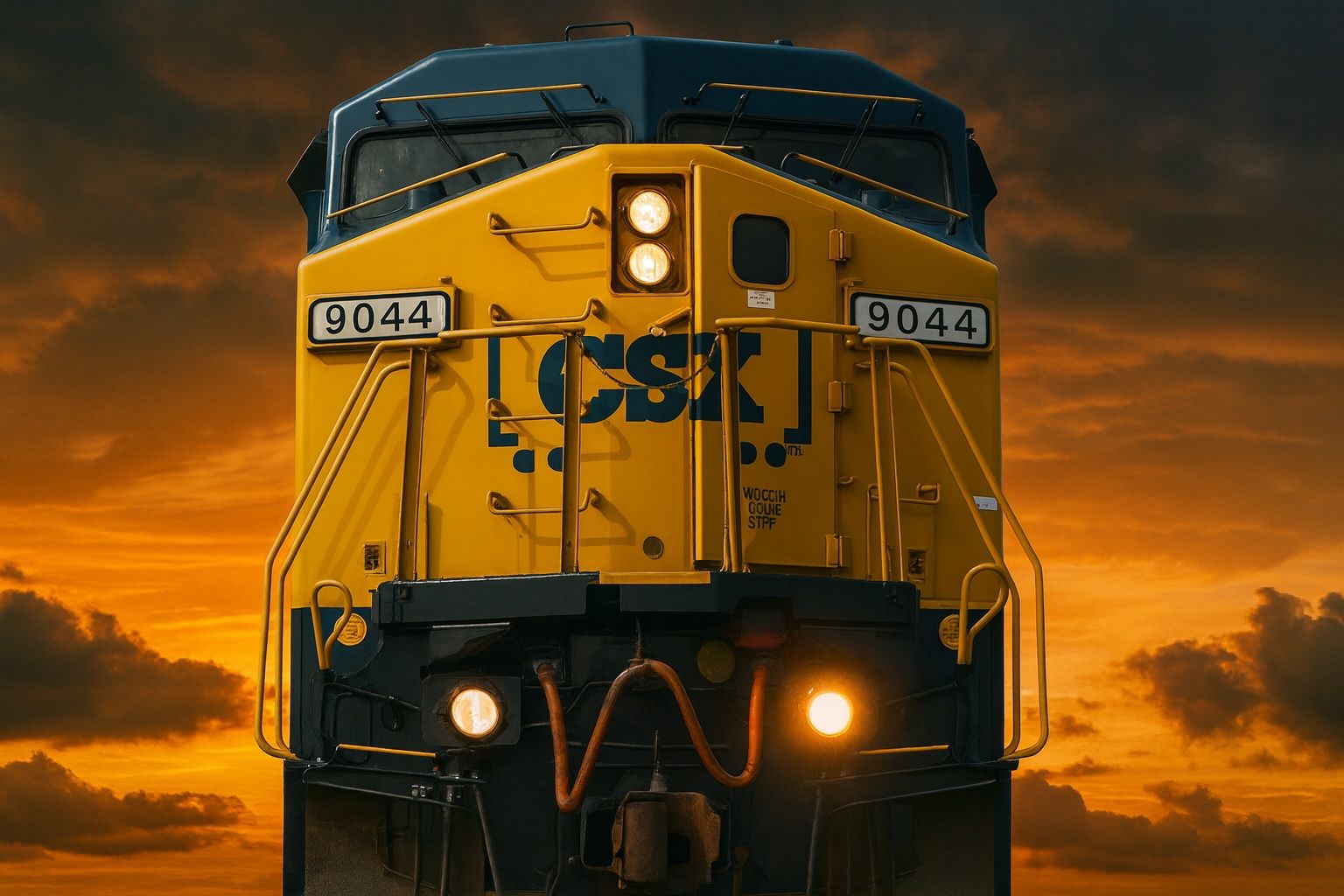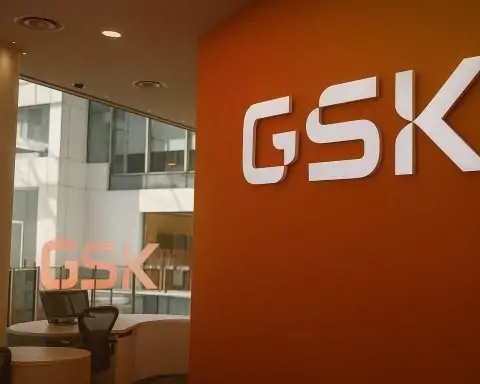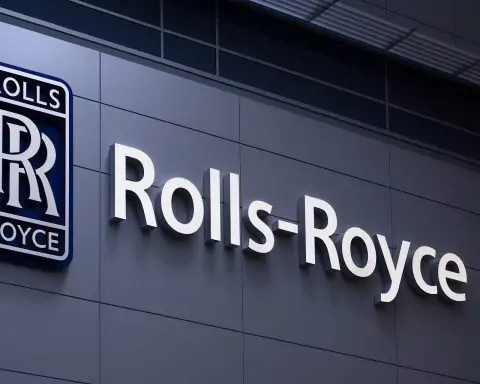- CSX stock climbs to around $36–$37, rising roughly 3% after an upbeat Q3 earnings report [1].
- Earnings beat expectations: Adjusted Q3 2025 profit was $0.44 per share, topping analyst estimates (~$0.42) [2]. Revenue of $3.59 billion was essentially in line with forecasts [3], as higher intermodal volumes and pricing helped offset weak coal demand [4].
- Profit down year-over-year: Net income fell 22% from a year ago due to one-time charges and earlier network disruptions [5], but freight volumes inched up ~1% as major construction projects wrapped up [6].
- New CEO at the helm: This was the first earnings release for new Chief Executive Steve Angel, installed Sept. 29 after a surprise leadership shakeup [7]. Angel’s appointment followed activist investor pressure – hedge fund Ancora had blasted CSX’s “anemic” performance and urged a merger or a new chief [8].
- Analysts optimistic but cautious: Wall Street maintains a “Buy” rating consensus on CSX [9]. The average 12-month price target is ~$38–$39 (about 5–7% above current levels) [10], with recent targets ranging from $32 up to $45 [11]. Analysts praise CSX’s improved operations and cost discipline, yet advise against hasty merger moves despite industry consolidation buzz [12].
- Rail industry at a crossroads: Investors are eyeing a pending $85 billion mega-merger between rival railroads Union Pacific and Norfolk Southern [13] – a deal that could create the first coast-to-coast U.S. rail network. CSX’s new leadership must decide whether to join the merger wave or rely on partnerships to stay competitive, as the rail freight landscape shifts.
Earnings Beat Lifts CSX Stock
CSX Corporation (NASDAQ: CSX) delivered stronger-than-expected third quarter results, boosting its stock price in recent trading. Shares of the Jacksonville-based freight railroad rose about 2–3% in after-hours trading following the earnings announcement [14]. CSX reported Q3 2025 net earnings of $694 million (or $0.37 per share) and an adjusted profit of $0.44 per share, which edged past consensus estimates of roughly $0.42 [15] [16]. This positive earnings surprise, albeit modest, encouraged investors and helped lift the stock toward the upper-$30s.
Revenue for the quarter came in at $3.59 billion, essentially flat (down 1% year-over-year) and roughly meeting forecasts [17]. The railroad managed to offset headwinds in its coal freight business – where low export coal prices dragged sales – by capitalizing on higher intermodal volumes and improved pricing in its merchandise shipping segment [18]. “Our domestic coal business continues to see steady trends through the year,” noted CSX Chief Operating Officer Mike Cory on the earnings call, pointing out that coal demand could rebound as policy shifts encourage more coal production [19]. In the meantime, growth in intermodal (rail-truck) shipments and pricing gains in consumer and industrial freight helped stabilize overall revenue.
Despite the earnings beat, CSX’s profits declined from a year ago, reflecting some one-time factors and earlier operational constraints. The reported $694 million profit was down ~22% year-over-year [20]. Last year’s Q3 saw $894 million in net income [21], so the drop is significant. However, executives stressed that excluding a $164 million goodwill impairment charge and other restructuring costs, the adjusted results show a more comparable performance [22]. On an adjusted basis, earnings of $0.44 per share were only slightly below the $0.46 a year prior [23] [24].
Notably, CSX’s network volume of freight grew about 1% from the prior year [25], indicating the railroad is moving more cargo even as revenue was flat. Management attributed the slower revenue to mix and pricing factors – for example, cheaper energy commodities – rather than an erosion of business. In fact, the company highlighted that it had recently completed major infrastructure projects, including repairs from a hurricane and a tunnel expansion in Baltimore, which had temporarily limited train traffic [26]. With those projects finished as of last month, CSX expects to see improved fluidity and capacity going forward. “This quarter’s operational performance reflects the dedication of our workforce and our commitment to running the best railroad in North America,” said CEO Steve Angel, adding that CSX is “well-positioned to build on this momentum” to drive long-term growth and shareholder value [27].
New CEO and Merger Pressure
The earnings release comes on the heels of a major leadership change at CSX. Just two weeks before the report, CEO Joe Hinrichs was abruptly replaced. On September 29, CSX announced that Steve Angel, a veteran industrial executive, would take over as President and CEO effective immediately [28]. Angel, 70, is new to the railroad industry – he previously led gas companies Praxair and Linde – but he does bring related experience (earlier in his career he ran GE’s locomotive division) [29]. His mandate is to guide CSX through its next phase of growth, and potentially through a period of industry consolidation that is ramping up across the rail sector.
The CEO shakeup was driven in part by activist investor unrest. Hedge fund Ancora Holdings had publicly lambasted CSX’s prior performance as “anemic” with “disastrous operational performance” under the former CEO [30]. In August, Ancora sent a fiery letter urging CSX’s board to “find another railroad to merge with… or fire” Hinrichs, reflecting frustration with the stock’s lackluster returns [31]. Another investor, Toms Capital, quietly amassed a stake and pushed for strategic talks, further fueling speculation that CSX might pursue a merger [32]. Faced with this pressure, CSX’s board moved swiftly – “less than two months” after Ancora’s letter – to install new leadership [33]. The day Angel’s appointment was announced, CSX’s stock jumped ~3% as the market reacted to the prospect of fresh direction [34].
Now at the helm, CEO Steve Angel must balance these investor demands with prudent strategy. Activist shareholders are clearly eager for bold moves: Ancora has signaled it would buy more shares if needed and expects the new CEO to aggressively seek “opportunities to increase shareholder value,” including identifying a merger partner [35]. However, industry experts urge caution. Jason Seidl, a rail analyst at TD Cowen, noted that while Angel may look to “position the railroad more strategically,” CSX “shouldn’t rush into any deals in the near term” [36]. In other words, immediate merger action isn’t necessarily the best course until the company strengthens its core operations and weighs all options. Angel himself has emphasized back-to-basics priorities – improving safety, service reliability, and growth on CSX’s existing network [37] – suggesting he won’t be pressured into a merger prematurely.
Analyst Insights and Stock Forecasts
By and large, Wall Street analysts have a positive view of CSX’s trajectory, though not without reservations. According to MarketBeat data, 24 analysts covering CSX give the stock a “Moderate Buy” consensus rating (roughly equivalent to an outright Buy) [38]. This reflects a broad expectation that CSX will outperform the market over the next year. The average 12-month price target for the stock sits around $38–$39 per share, which implies a modest upside of about 5–7% from the latest ~$36 share price [39]. Price predictions do vary: the most bullish analysts see CSX reaching $45 (roughly 25% above current levels), while on the low end one target is around $32 (about 10% below current) [40]. In general, though, the recent earnings beat and operational improvements have reinforced the bullish case more than the bearish one.
A number of financial analysts have raised their targets or reiterated confidence in CSX after observing improving trends. For example, Citigroup and J.P. Morgan both updated their outlooks in early October, each assigning price targets near $40 per share [41] [42]. Morgan Stanley also reportedly revised its target upward to around $42, highlighting CSX’s enhanced cost controls and momentum in service performance [43]. These moves signal that major institutions see additional upside if the company can execute well. Analysts have pointed out catalysts such as better expense discipline, higher network efficiency, and recovering freight demand that could drive earnings higher in coming quarters.
That said, short-term challenges are acknowledged. High interest rates and economic uncertainties continue to weigh on freight volumes in some segments, and CSX’s exposure to coal (a shrinking market long-term) remains a drag [44]. Some analysts adopting a “Hold” rating argue the stock’s valuation already reflects much of the near-term improvement, keeping them more neutral until there’s clearer evidence of volume growth or a transformative deal. Currently, about 6 of the 24 analysts rate CSX a Hold, versus 18 recommending Buy [45] – indicating a minority are cautious but no major voices are outright bearish on the company.
In terms of future earnings, consensus forecasts compiled by Stock Analysis expect CSX’s revenues to tick up roughly 4–5% next year (to around $15 billion in 2026) as economic conditions improve [46]. Earnings per share are projected to rise closer to $1.95 next year from about $1.69 this year (approximately +15%), assuming the railroad benefits from its recent capital projects and efficiency measures [47]. These forecasts suggest analysts see medium-term growth accelerating for CSX, provided there are no major downturns. Overall, the sentiment is that CSX’s fundamentals are solid – a well-run rail network with improving service metrics – and that its stock can grind higher, even if not dramatically, over the next year.
Broader Outlook for Investors and the Rail Sector
CSX’s latest developments come at a pivotal moment for the rail transportation sector. The industry is experiencing what some are calling a rail merger frenzy [48]. This year, western rival Union Pacific agreed to acquire Norfolk Southern in a blockbuster $85 billion deal [49] [50]. If approved by regulators, that merger would create the first true coast-to-coast railroad in U.S. history – a single network spanning from the Pacific to the Atlantic. Such a transcontinental giant could shave a full day off shipping times by eliminating handoffs between carriers [51]. For customers, that promises faster deliveries; for remaining competitors like CSX, it raises the competitive stakes.
Most industry observers believe that if the Union Pacific–Norfolk Southern deal goes through, CSX and BNSF (the major freight line in the western U.S. owned by Berkshire Hathaway) could be at a disadvantage [52]. They’d be the only two big railroads left without a coast-to-coast reach. It’s one reason activists have pressed CSX to consider finding a merger partner – potentially joining with BNSF or Canadian Pacific Kansas City (CPKC) – to level the playing field [53]. However, both BNSF and CPKC have publicly stated they are not interested in merging with CSX at this time [54]. These rivals argue that the industry can serve customers well through cooperative agreements and alliances, without the “headaches” of a merger [55]. In fact, CSX has already taken that route: earlier this year it struck new interline service agreements with BNSF and Canadian National Railway to interchange traffic more seamlessly [56]. Such partnerships aim to mimic some benefits of a merger (like broader network coverage) without the complexities of a full corporate integration.
For investors in CSX, the coming months will be telling. On one hand, the company’s core business appears to be stabilizing – volume is growing again, operations are running more smoothly, and management is forecasting a manageable capital spending plan of about $2.5 billion for 2025 [57] to maintain and upgrade the railroad (excluding any one-time storm repair costs). These are encouraging signs that CSX can continue to generate solid cash flow and return value to shareholders (the company has a history of dividends and share buybacks). Additionally, a pro-industrial political climate – for example, new policies that encourage coal and manufacturing – could provide a short-term demand boost for freight volumes [58], benefiting railroads like CSX.
On the other hand, the strategic question of mergers vs. stand-alone strategy looms large. If the Union Pacific–NS merger wins approval (which seems likely given support even from labor unions and politicians [59]), CSX may eventually feel compelled to respond. Regulators have signaled a more merger-friendly stance lately [60], so further consolidation cannot be ruled out. A merger involving CSX would be a massive undertaking but could unlock significant efficiencies and route advantages. Short of that, investors will be watching how effectively CSX’s new CEO can improve the company’s competitiveness on his own. Steve Angel’s track record of executing a major merger (Praxair-Linde) and driving cost efficiencies is a point of confidence [61]. If he can similarly streamline CSX and boost growth without a merger, the stock could see renewed investor interest.
In the near term, most analysts seem to agree that CSX should focus on executing its current plan – improving service, controlling costs, and growing volume organically [62]. The railroad’s recent performance indicates it is on the right track operationally, which is crucial regardless of any M&A possibilities. For the rail/transportation sector as a whole, CSX’s results and moves are seen as a bellwether. They suggest that while freight demand has been mixed, the sector is navigating challenges through efficiency gains and targeted growth areas (like intermodal). Retail investors following CSX should keep an eye on upcoming developments: any hints of merger discussions, the progress of the rival rail merger approval, and CSX’s own quarterly trends under the new CEO. So far, the company is signaling optimism – reaffirming that it expects volume growth for the full year [63] – and the stock’s latest bump reflects a cautiously hopeful outlook. In an era of both opportunities and uncertainties for railroads, CSX is a company at the crossroads, striving to deliver steady returns now while positioning for whatever the future of rail transport may hold.
Sources: Official earnings release [64] [65]; Associated Press [66] [67]; Reuters [68] [69]; TechStock² (ts2.tech) analysis [70] [71]; MarketBeat consensus data [72] [73].
References
1. www.reuters.com, 2. www.timesunion.com, 3. www.reuters.com, 4. www.reuters.com, 5. thebusinessjournal.com, 6. thebusinessjournal.com, 7. ts2.tech, 8. ts2.tech, 9. www.marketbeat.com, 10. www.marketbeat.com, 11. www.marketbeat.com, 12. ts2.tech, 13. www.reuters.com, 14. www.reuters.com, 15. www.timesunion.com, 16. www.reuters.com, 17. www.reuters.com, 18. www.reuters.com, 19. www.reuters.com, 20. thebusinessjournal.com, 21. thebusinessjournal.com, 22. thebusinessjournal.com, 23. www.globenewswire.com, 24. thebusinessjournal.com, 25. www.globenewswire.com, 26. thebusinessjournal.com, 27. www.globenewswire.com, 28. ts2.tech, 29. thebusinessjournal.com, 30. ts2.tech, 31. ts2.tech, 32. ts2.tech, 33. ts2.tech, 34. ts2.tech, 35. ts2.tech, 36. ts2.tech, 37. ts2.tech, 38. www.marketbeat.com, 39. www.marketbeat.com, 40. www.marketbeat.com, 41. stockanalysis.com, 42. stockanalysis.com, 43. finance.yahoo.com, 44. www.reuters.com, 45. www.marketbeat.com, 46. stockanalysis.com, 47. stockanalysis.com, 48. ts2.tech, 49. ts2.tech, 50. www.reuters.com, 51. thebusinessjournal.com, 52. thebusinessjournal.com, 53. thebusinessjournal.com, 54. thebusinessjournal.com, 55. thebusinessjournal.com, 56. www.reuters.com, 57. www.reuters.com, 58. www.reuters.com, 59. ts2.tech, 60. ts2.tech, 61. ts2.tech, 62. ts2.tech, 63. ts2.tech, 64. www.globenewswire.com, 65. www.globenewswire.com, 66. thebusinessjournal.com, 67. thebusinessjournal.com, 68. www.reuters.com, 69. www.reuters.com, 70. ts2.tech, 71. ts2.tech, 72. www.marketbeat.com, 73. www.marketbeat.com







